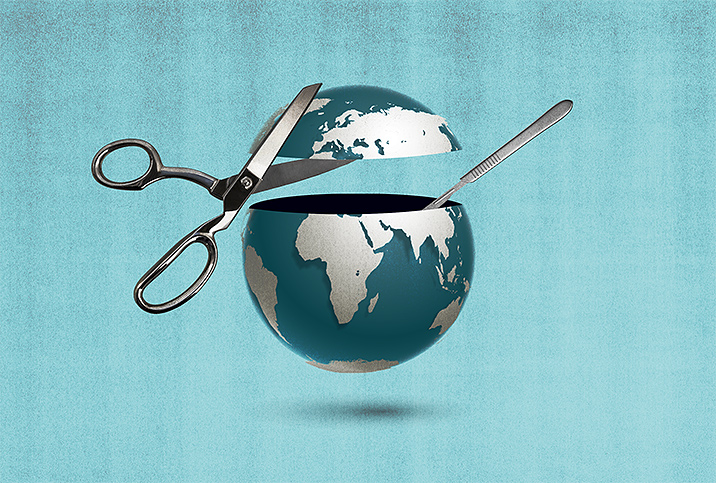How Can I Restore My Foreskin to Its Former Glory?

Editor's note: Some of the sources for this article requested their full names and locations not be used.
Hans, an IT worker, began a journey to reclaim his foreskin in 2014 after a psychedelic experience in Amsterdam. In this state of revelatory intoxication, an absence lingering in the back of his mind shifted to the forefront.
Hans always felt like something was off with his body, even before knowing what foreskin was. He compared the feeling to phantom limb syndrome, where individuals feel sensations in a limb that was either removed or never existed. Now he feels that what was missing for so long was his foreskin.
"That [psychedelic experience] sort of ticked off some more research, and then discovering that there's quite a lot that's actually missing," Hans said.
Hans began the process of foreskin restoration, a set of techniques aimed at stretching the skin of a circumcised penis to reproduce a functional foreskin. Several years later, he said the experience has been broadly positive and he's happy with the results. With his foreskin restored, he's feeling much more body positive.
Today, Hans is a moderator of r/foreskin_restoration, a subreddit with over 25,000 users. It's a community of mostly men, most of whom were circumcised as infants and are interested in "undoing" that procedure.
Foreskin restoration through history
Foreskin is a sheath of skin that covers the head (glans) of the penis and is fully attached to the penis at birth. Circumcision, the surgical removal of the foreskin, may be performed after birth based on family traditions, religious beliefs or cosmetic preferences, among other reasons.
Despite its new home on the internet, the practice of foreskin restoration dates back as far as ancient Greece, according to "Uncircumcision: A Historical Review of Preputial Restoration," an article published in the journal Plastic and Reconstructive Surgery.
Procedures to surgically or manually restore foreskin were most often in demand during eras of political and religious persecution of Jewish people, with whom the practice of circumcision has been strongly associated throughout history.
The Old Testament of the Bible mentions Jews practicing "uncircumcision" in ancient Greece during the reign of Antiochus IV, under whom circumcision was punishable by death. Surgical restoration was believed to be common in Nazi Germany, where a circumcised penis could be considered evidence of Jewish heritage.
The paper traces the modern foreskin restoration movement to around the 1980s, when attitudes toward routine infant circumcision began to shift. More men began to express resentment toward being cut as infants, citing a suspected loss of sexual pleasure or the feeling that their bodies had been altered without their consent.
With this shift in sentiment, new organizations opposing infant circumcision sprung up around the world, and along with them, a group of men looking to reclaim what was taken from them.
Why restore your foreskin?
Most people undertake foreskin restoration with the goal of increasing pleasure during sex, said Peter N. Schlegel, M.D., a professor of urology and reproductive medicine at Weill Cornell Medicine in New York City.
It's difficult to definitively prove that circumcision leads to the loss of sexual sensation later in life because pleasure is subjective, and subjects who have experienced sex with and without their foreskin are few and far between, Schlegel explained.
But there are theoretical reasons to suspect that circumcision leads to decreased sexual pleasure. The skin around the head of the penis is a highly sensitive area, so it's plausible that people with less skin there would experience less sensation.
The foreskin also protects the glans and keeps it moist, and removing this layer of protection may lead to decreased sensitivity over time.
"By having a circumcision, skin is exposed all of the time," Schlegel said. "It dries out more and it develops an extra layer on top of it, what is called keratin, which is basically a protein that essentially makes the skin a little bit tougher."
How to restore your foreskin
There are both surgical and nonsurgical means of restoring foreskin. Surgical foreskin restoration involves transplanting skin from other parts of the body onto the penis. But most patients opt for nonsurgical restoration techniques, Schlegel said.
The basic principle of nonsurgical foreskin restoration involves applying repeated, gentle tension to the skin of the penis. This could involve tugging by hand or by affixing weights, tape or specialized restoration devices to the looser skin near the head of the penis.
Eventually, the tension begins to stretch and lengthen the skin. This process is typically slow: It often takes weeks or months to see any extension. Many of the restorers on r/foreskin_restoration report spending years on this process.
The stretched penile skin resulting from prolonged tension isn't exactly the same as an uncut foreskin, but potentially restores some of the benefits of one.
"It's not as wet," Schlegel said. "It's not a mucous membrane to the same degree. But it has some of the characteristics, meaning it protects the head of the penis so that it can potentially have more sensitivity."
Despite being a relatively fringe medical practice, nonsurgical foreskin restoration is reasonably safe, according to Schlegel.
A beginner's guide on the r/foreskin_restoration subreddit emphasizes the process should never be painful.
"Safety is only a concern if you start pulling on the skin too aggressively to the point where you cause [a] tear or damage to the skin or create scar tissue," Schlegel said. "The risk of any of those things occurring is relatively small."
Got those ol' circumcision blues
Users on the r/foreskin_restoration subreddit often express severe dissatisfaction with their circumcisions. This was the case for Tim, another moderator of the forum and a human rights attorney from Australia.
As Tim aged, he found he was losing sensation in his penis. He began to withdraw from intimacy with his wife, who has since died, he said. But even today, the memory of this sexual dysfunction causes him pain.
"We didn't really understand why that was occurring. She thought there was something repulsive about her," he said. "But it was me."
It wasn't just the loss of sexual pleasure that bothered Tim, though. He described intense body dysmorphia related to his circumcised penis. He shunned nakedness, feeling a profound sense of exposure due to his bare glans.
In 2016, Tim's wife stumbled upon the topic of foreskin restoration online, and she was the one who encouraged him to start. Initially, he used manual tugging techniques before moving on to a set of specialized devices.
After six years of attempting restoration, Tim said he hasn't quite reached the level of foreskin coverage he'd like. Nonetheless, he feels a sense of deep gratitude that his wife encouraged him to begin the process.
"I can happily stand now and look at the naked man in the mirror and feel like a whole man once more," he said.
'Intactivism' against circumcision
There's nothing inherently political about attempting to restore a person's foreskin. But the same dissatisfaction that drives people to restore also pushes them toward anti-circumcision activism, or "intactivism" as it is called by practitioners.
For Ron Low, founder TLC Tugger, a restoration device company based in Chicago, intactivism is woven into his business. Low can be found handing out intactivist leaflets at pride parades, medical conventions and baby fairs in cities across America. He's written anti-circumcision parody songs and peppered his online storefront with intactivist literature.
Low, like the other two restorers, argued that circumcision is a violation of bodily autonomy.
"Circumcision in North America is most often forced on a healthy child, which is unethical since it could just as easily wait for the patient's informed input," he said.
Low is not compelled by the positions of public health bodies, such as the Centers for Disease Control and Prevention (CDC) and the World Health Organization (WHO), that suggest circumcision might improve sexual health outcomes. His website points to public health bodies such as the Royal Dutch Medical Association, which asserts that "there is no convincing evidence that circumcision is useful or necessary in terms of prevention or hygiene."
Low said he isn't seeking to ban circumcision outright. Instead, he hopes the procedure can someday be limited to consenting adults—even if that means his devices become obsolete.
"I respect the rights [of people] to believe what they want to believe, but also I respect the right of that child to grow and be a person that has his own beliefs," he said.


















